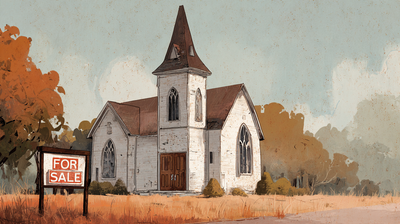Why Churches Are Closing — And What Healthy Church Models Look Like Today
The headlines tell a sobering story: another church building for sale, another congregation disbanding, another century-old sanctuary converted into condos or commercial space. If you've driven through small towns or even urban neighborhoods lately, you've probably seen the signs yourself — literally. "For Sale" placards hang outside buildings where generations once gathered to worship, learn, and find community.
Church closure trends across America have accelerated in recent years, with some estimates suggesting that more churches close their doors than open new ones each year. Declining church attendance and church membership decline have become statistical realities that denominational leaders can no longer ignore. Post-pandemic worship patterns, shifting cultural values, and generational changes have created what many are calling a crisis for traditional American Christianity.
But here's what the doom-and-gloom headlines miss: while many churches are indeed shutting down, others are not just surviving — they're thriving. The difference isn't luck or location. It's a fundamental reimagining of what it means to be a missional church in 2025. These healthy church models are proving that the future of the church isn't about bigger buildings or flashier programs. It's about getting back to the biblical basics of loving God and serving neighbors in tangible, transformative ways.
Why Churches Are Closing
Understanding church closures in America requires looking beyond surface-level statistics to the deeper cultural shifts reshaping how people approach faith, community, and institutional commitment. The reasons behind church shutdowns are complex and interconnected, but several key factors emerge consistently across denominational lines.
Cultural and Generational Shifts
The most significant driver of declining church attendance is the fundamental shift in how younger generations view organized religion. Unlike their parents and grandparents, Millennials and Gen Z approach faith with skepticism toward institutional authority and traditional structures. They're more likely to describe themselves as "spiritual but not religious" and less likely to see weekly church attendance as essential to their faith journey.
"Therefore go and make disciples of all nations, baptizing them in the name of the Father and of the Son and of the Holy Spirit, and teaching them to obey everything I have commanded you."
— Matthew 28:19-20
The Great Commission calls the church to make disciples, but many congregations have struggled to connect this biblical mandate with the questions and concerns of younger generations. When churches fail to address real-life issues with biblical truth, or when they seem more focused on preserving tradition than pursuing Christ's mission, young adults often walk away.
Post-Pandemic Realities
The COVID-19 pandemic accelerated trends that were already in motion. Forced to move online, many churches discovered that a significant portion of their congregation was comfortable worshiping from home. While this opened new opportunities for digital ministry, it also revealed how shallow some people's church commitment really was.
More importantly, the pandemic exposed which churches had built their identity around gathering for services versus serving their communities. Churches that had invested heavily in internal programs but had little community presence found themselves struggling to demonstrate relevance during a time of widespread need.
Financial Struggles and Leadership Challenges
Church membership decline inevitably leads to financial strain. Smaller congregations struggle to maintain aging buildings, support pastoral salaries, and fund ministry programs with shrinking giving. Many churches face a vicious cycle: declining attendance leads to budget cuts, which leads to reduced ministry effectiveness, which leads to further attendance decline.
Leadership health issues compound these challenges. Pastor burnout, board conflicts, and generational disagreements about church direction create internal turmoil that drives people away. When church leadership is focused on managing decline rather than pursuing growth, the congregation often senses the lack of vision and hope.
"Where there is no vision, the people perish."
— Proverbs 29:18 (KJV)
This ancient wisdom remains painfully relevant. Churches without clear biblical vision and compelling mission often find themselves merely maintaining tradition rather than making disciples.
Signs of a Dying Church
Recognizing the signs of a dying church isn't about judgment or condemnation — it's about honest assessment that can lead to renewal. Church vitality depends on more than attendance numbers or budget size. The health of a congregation can be measured by its focus, its fruit, and its future orientation.
Inward Focus Over Outward Mission
One of the clearest signs of church decline is an inward focus that prioritizes member comfort over community mission. These congregations spend most of their resources on internal programs, facility maintenance, and member preferences rather than reaching their neighborhoods with the Gospel.
You can often spot this in church conversations. Healthy churches talk about the people they're serving and the problems they're solving in their community. Dying churches talk about preserving traditions, managing budgets, and keeping members happy. The difference in focus reveals the difference in spiritual health.
"For even the Son of Man did not come to be served, but to serve, and to give his life as a ransom for many."
— Mark 10:45
Jesus modeled servant leadership and outward focus. Churches that lose this servant heart often lose their spiritual vitality as well.
Declining Discipleship Culture
Another critical indicator is the absence of intentional discipleship. Healthy churches don't just add members — they make disciples. When congregations focus primarily on attracting attendees rather than developing mature believers who can serve and lead, they create a consumer culture rather than a discipleship culture.
This shows up in several ways: minimal Bible study participation, low volunteer engagement, little personal spiritual growth among members, and an expectation that the pastor and staff will do the ministry work while members simply attend services.
Poor Leadership Health and Vision Drift
Leadership problems often signal deeper church health issues. When pastoral teams lack clear vision, when board meetings focus on maintenance rather than mission, when there's frequent conflict between leaders, or when decision-making processes are unclear or unhealthy, the congregation suffers.
Vision drift is particularly dangerous. Churches that once had clear biblical purpose but have gradually shifted their focus to cultural accommodation or institutional preservation often lose their spiritual edge and evangelistic effectiveness.
Resistance to Necessary Change
Perhaps the most telling sign of a dying church is rigid resistance to change, even when current approaches aren't working. This doesn't mean abandoning biblical truth — that never changes. But it does mean being willing to adapt methods, programs, and structures to better serve God's purposes in changing cultural contexts.
"But new wine must be put into new wineskins."
— Luke 5:38
Jesus taught that new realities sometimes require new approaches. Churches that insist on maintaining old methods simply because "we've always done it this way" often struggle to remain relevant and effective in their communities.
What Healthy Church Models Look Like Today
While many churches are struggling, others are demonstrating what healthy church models can look like in 2025. These thriving congregations share common characteristics that reflect biblical priorities while engaging contemporary culture effectively. They've learned to balance theological faithfulness with methodological flexibility.
Community-Centered Mission
The healthiest churches today have shifted from an attractional model ("come and see") to a missional model ("go and serve"). Instead of focusing primarily on getting people to come to church, they focus on taking the church to people through practical service and authentic relationships.
This means understanding their community's actual needs and developing ministries that address those needs with Gospel motivation. Whether it's food insecurity, mental health struggles, job training, or family support, these churches become known in their neighborhoods as places where people can find help, hope, and genuine care.
"All the believers were together and had everything in common. They sold property and possessions to give to anyone who had need."
— Acts 2:44-45
The early church's reputation was built on radical generosity and practical care for people's needs. Modern healthy churches are rediscovering this pattern.
Excellence in Execution
Healthy church models prioritize doing things well rather than doing everything. Instead of spreading resources thin across numerous mediocre programs, they identify their core strengths and execute them with excellence. This might mean having fewer ministries but ensuring that each one is effective, well-resourced, and aligned with their mission.
This principle applies to everything from worship services to community outreach. When churches do things well, it demonstrates respect for both God and the people they serve. Sloppy execution communicates that the ministry isn't worth doing properly.
Gospel-Centered Service
What distinguishes Christian community service from secular social work is the Gospel motivation and the ultimate hope offered. Healthy churches serve their communities excellently while remaining clear about why they serve and what unique hope they offer through Jesus Christ.
This isn't about making service conditional on hearing a Gospel presentation. Rather, it's about serving with such excellence and love that people naturally ask about the motivation, creating organic opportunities for Gospel conversations.
"In the same way, let your light shine before others, that they may see your good deeds and glorify your Father in heaven."
— Matthew 5:16
Good works become a platform for Gospel witness when they're motivated by love for God and genuine care for people.
Flexible Facility Models
Many healthy churches are rethinking traditional facility models. Instead of building large sanctuaries that sit empty most of the week, they're investing in multi-purpose spaces that serve their communities seven days a week. This might include coffee shops, community meeting rooms, childcare facilities, or co-working spaces.
Some are embracing hybrid church models that combine online and in-person elements effectively. Others are exploring house church networks or meeting in rented spaces that allow them to invest more resources in ministry rather than building maintenance.
Need help creating faith-filled content for your blog or ministry? I offer Christian blog writing, devotional writing, and SEO content services.
Work with me here →A Modern Example — Community Before Religion
Let me share a personal story that illustrates what a modern missional church can look like in practice. Recently, I visited a church that completely changed my understanding of what community-centered ministry could accomplish.
Meeting Real Needs First
This congregation had transformed their approach to community engagement by starting with a simple question: "What does our neighborhood actually need?" Instead of assuming people needed church services, they built relationships with local organizations to understand real challenges.
Their research revealed pressing needs for healthcare access, food security, and family support services. Rather than starting with religious programming and hoping people would attend, they began offering practical solutions to these problems.
The church partnered with local healthcare providers to establish a free health clinic in their facility. They converted part of their building into a food bank and community resource center. They started support groups for addiction recovery and cancer support.
"Religion that God our Father accepts as pure and faultless is this: to look after orphans and widows in their distress and to keep oneself from being polluted by the world."
— James 1:27
This church understood that authentic faith expresses itself through caring for vulnerable people, not through religious activities alone.
Creating Connection Spaces
Recognizing that modern life often lacks genuine community connections, they invested in creating spaces where relationships could develop naturally. They opened a coffee shop in part of their building that served excellent coffee and provided a welcoming environment for neighbors to meet, work, or simply enjoy community.
Sunday mornings included not just worship services but also breakfast gatherings where families could share meals and build friendships. These weren't evangelistic events with hidden agendas — they were genuine attempts to create the kind of community that people were missing in their lives.
Investing in Families
The most remarkable example of their community investment was their decision to start free youth sports leagues. Using their facilities and volunteers from the congregation, they offered basketball and soccer leagues for neighborhood children at no cost to families.
I’ll never forget the story of an older brother who broke down in tears when he discovered his younger brother could finally play soccer for free—uniforms and equipment included. He himself had only been able to play for two short years before the school shut down its sports program, and he thought his little brother would never get the chance. Overcome with gratitude, he promised to be at every single one of his brother’s games to cheer him on and support the league. This brother duo experienced the kind of practical love that opens hearts to spiritual truth.
These sports leagues weren't just recreational activities — they became platforms for mentoring, family support, and community building. Volunteer coaches from the church built relationships with kids and families that extended far beyond game days.
Serving Without Strings
Perhaps the most powerful aspect of this church's approach was their commitment to serving without strings attached. They didn't require people to attend services to access the food bank. They didn't make the healthcare clinic conditional on hearing a Gospel presentation. They didn't use the sports leagues as captive audiences for evangelistic events.
Instead, they served with such excellence and genuine care that people naturally became curious about their motivation. When conversations about faith happened, they were organic and welcome rather than forced or manipulative.
"By this everyone will know that you are my disciples, if you love one another."
— John 13:35
Their love for the community became the most powerful evangelistic tool they possessed. People could see that this congregation's faith was authentic because it expressed itself through sacrificial service.
This is what a healthy church model looks like today — faith that expresses itself through love, service that creates platforms for Gospel witness, and community transformation that demonstrates God's kingdom values in practical ways.
Movements Shaping the Future of the Church
The landscape of American Christianity is being reshaped by several significant movements that offer hope for the future of the church. These trends suggest that while traditional models may be struggling, innovative approaches to church life and mission are creating new opportunities for Gospel impact and spiritual growth.
Church Planting Movement
One of the most encouraging trends is the growing church planting movement across denominational lines. Rather than trying to revitalize struggling congregations, many leaders are choosing to start fresh with new churches that are designed from the ground up to serve their specific communities effectively.
These new church plants often begin with smaller, more sustainable models that prioritize mission over facilities. Many start in homes, community centers, or rented spaces, allowing them to invest more resources in ministry rather than building maintenance. This approach creates opportunities for more focused discipleship and community engagement.
"And I tell you that you are Peter, and on this rock I will build my church, and the gates of Hades will not overcome it."
— Matthew 16:18
Jesus promised that He would build His church, and the church planting movement demonstrates His continued faithfulness to that promise through new congregations that are passionate about Gospel mission.
House Church and Micro-Church Models
The house church movement is experiencing significant growth, particularly among younger Christians who value authentic community over institutional structures. These smaller gatherings often provide deeper relationships, more participatory worship, and clearer pathways for spiritual growth and leadership development.
Micro-churches typically involve 15-50 people meeting in homes or small venues, allowing for more intimate fellowship while still maintaining connection to broader church networks for accountability, training, and mission support. This model often proves more sustainable financially and emotionally than traditional large church structures.
Hybrid and Technology-Integrated Models
The pandemic accelerated the development of hybrid church models that effectively combine online and in-person elements. Rather than seeing digital ministry as a temporary accommodation, many churches are discovering that technology can extend their reach and provide new opportunities for discipleship and community connection.
Successful hybrid models use technology strategically to enhance rather than replace human relationships. This might include online small groups, digital discipleship resources, livestreamed services with interactive elements, or social media platforms that facilitate ongoing spiritual conversations.
Sustainable Ministry Approaches
Perhaps most importantly, there's growing recognition that ministry sustainability requires healthier approaches to leadership, finances, and community engagement. This includes acceptance of bivocational pastoral models, shared leadership structures, and collaborative approaches that distribute ministry responsibilities more broadly among congregation members.
Many healthy churches are also exploring shared facilities, cooperative ministries with other congregations, and partnership approaches that allow smaller churches to accomplish larger mission goals together.
"Two are better than one, because they have a good return for their labor: If either of them falls down, one can help the other up."
— Ecclesiastes 4:9-10
Collaborative ministry models reflect biblical wisdom about the strength found in partnership and mutual support.
Building Resilient Churches for 2025 and Beyond
Creating sustainable ministry that can thrive in changing cultural contexts requires intentional focus on several key areas. Churches that want to build resilience for the future must address financial sustainability, leadership development, community impact, and Gospel witness in integrated ways.
Financial Resilience and Resource Stewardship
Sustainable ministry begins with realistic financial planning that doesn't depend on constant growth to remain viable. This often means embracing simpler facility models, collaborative resource sharing, and diversified funding approaches that include but don't exclusively depend on member giving.
Many resilient churches are exploring creative funding through community partnerships, facility rental income, social enterprise initiatives, or cooperative arrangements with other congregations. The goal isn't to eliminate dependence on member generosity, but to create financial stability that allows for consistent ministry even during challenging seasons.
Bivocational pastoral models are becoming more common and often prove healthier for both pastors and congregations. When pastors maintain other income sources, it can reduce financial pressure on small churches while also providing pastors with valuable connections to the broader community.
Leadership Development and Discipleship Culture
Resilient churches prioritize developing leaders from within their congregations rather than depending entirely on professional clergy. This requires intentional discipleship programs that equip members for ministry, leadership, and Gospel witness in their daily lives.
"So Christ himself gave the apostles, the prophets, the evangelists, the pastors and teachers, to equip his people for works of service, so that the body of Christ may be built up."
— Ephesians 4:11-12
The biblical model shows pastoral leadership functioning primarily to equip members for ministry rather than doing all the ministry themselves. Churches that embrace this model often prove more sustainable and effective.
Healthy leadership development also includes succession planning, conflict resolution skills, and team-based decision making that can weather the inevitable challenges that churches face over time.
Community Impact and Gospel Witness
Churches that want to build long-term resilience must establish genuine connections with their communities through consistent service and authentic relationships. This isn't just about church growth — it's about fulfilling the biblical mandate to love neighbors and demonstrate God's kingdom values.
Community impact creates natural opportunities for Gospel conversations while also building goodwill that helps churches weather cultural changes and criticism. When churches are known for their positive contributions to community life, they often find more support during difficult seasons.
Encouraging the Faithful
For readers who are concerned about the future of the church, remember that decline in some areas doesn't mean the church is dying globally. God is raising up new models, new leaders, and new movements that demonstrate His continued faithfulness to build His church.
If you're part of a struggling congregation, consider what changes might be needed to better serve your community and fulfill the Great Commission. If you're looking for a church home, seek congregations that demonstrate both biblical faithfulness and missional engagement with their neighbors.
"And let us consider how we may spur one another on toward love and good deeds, not giving up meeting together, as some are in the habit of doing, but encouraging one another—and all the more as you see the Day approaching."
— Hebrews 10:24-25
The call to gather as believers remains important, but the purpose of gathering is to be equipped and encouraged for love and service that extends far beyond church walls.
Final Thoughts
The story of church closures in America is real and sobering, but it's not the complete story. While many congregations are indeed closing their doors, others are discovering what it means to be the church in ways that are both biblically faithful and culturally relevant. The difference lies not in size, resources, or location, but in understanding that healthy church models prioritize mission over maintenance, service over self-preservation, and community transformation over institutional survival.
The thriving churches of 2025 won't be distinguished by their buildings or budgets, but by their commitment to loving God and serving neighbors in tangible, transformative ways. They'll be known in their communities as places where people can find help, hope, and authentic relationships that point toward the Gospel.
The future of the church isn't about preserving traditional structures that may no longer serve God's purposes effectively. It's about rediscovering the biblical priorities that make churches genuinely valuable to their communities and faithful to Christ's mission. Whether through church plants, house churches, hybrid models, or renewed traditional congregations, God continues to build His church through people who are willing to serve sacrificially and love unconditionally.
If you're concerned about the church's future, be encouraged. The same Jesus who promised to build His church is still working through His people to create communities of faith, hope, and love that transform neighborhoods and change lives. The question isn't whether the church will survive — it's whether we'll be faithful to participate in what God is doing to make His church more effective, more loving, and more missional than ever before.









